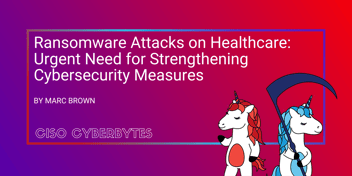In today's digital landscape, where cyber threats constantly evolve and become more sophisticated, vulnerability management has emerged as a critical 'must-have' cybersecurity platform. Organizations invest heavily in Vulnerability Management (VM) platforms to manage security vulnerabilities within their IT and OT/ICS environments. However, despite the vast capabilities of VM, teams continue to face significant challenges, with prioritization ranking among the most urgent issues facing an organization, further exacerbating CISO's concerns around risk exposure.
In this blog, we'll explore the persistent challenges of threat prioritization and discuss how SCYTHE's approach to threat intelligence and understanding can revolutionize this crucial aspect of security operations.
The State of Vulnerability Management
Vulnerability management platforms have undoubtedly improved over the years, providing organizations with tools to identify and track vulnerabilities across their networks and systems. These platforms use various techniques, such as automated scans and data aggregation, to compile extensive lists of vulnerabilities. However, the sheer volume and lack of business context of vulnerabilities often overwhelm security teams, making it challenging to determine which vulnerabilities should be addressed first, increasing cost, time, and risk.
The Prioritization Predicament
One of the fundamental problems with traditional VM platforms is that they tend to generate long lists of vulnerabilities with limited context. Security teams are left grappling with a multitude of vulnerabilities, many of which may pose a minor threat to the organization. The result? An overwhelmed team that is struggling to prioritize and allocate resources effectively.
Each year, CISOs cite prioritization as one of their top concerns. According to the Ponemon Institute's "2022 State of Vulnerability Management" report, 71% of organizations reported that the "inability to prioritize vulnerabilities effectively" was a significant barrier to managing vulnerabilities. This challenge impacts the efficiency of security teams and leaves organizations exposed to potentially devastating cyberattacks.
The Need for Contextual Understanding
To address this issue, it's crucial to recognize that not all vulnerabilities are created equal. Vulnerability severity alone doesn't provide sufficient context for effective prioritization. Security teams must understand how vulnerabilities could impact their specific environment and business operations.
For example, a critical vulnerability in a widely used software application may only be a top priority if it exists within an organization's environment. Conversely, a lower severity vulnerability in a less common system could be an immediate threat if it exposes a critical asset. Prioritization must consider the "business context" of vulnerabilities, weighing factors such as asset importance, exposure to threats, and potential impact on operations.
The SCYTHE Solution: Leveraging Threat Intelligence and Understanding
SCYTHE, a leader in adversarial emulation, offers a unique perspective on solving the prioritization problem in vulnerability management. By combining advanced threat emulation with comprehensive threat intelligence, SCYTHE enables organizations to contextualize vulnerabilities within their specific environments.
SCYTHE's approach starts with understanding the threat landscape. It leverages real-time threat intelligence to identify the most relevant and emerging threats. This intelligence is then used to refine the prioritization process. For instance, if a particular vulnerability aligns with a known and active threat actor's tactics, techniques, and procedures (TTPs), it is elevated in priority.
Furthermore, SCYTHE's threat understanding extends beyond just severity ratings. It considers factors such as the scope of the exploit, the potential impact on critical assets, and the existence of known exploits in the wild. This granular threat understanding provides security teams with actionable insights.
Real-World Prioritization with SCYTHE
Let's consider a real-world scenario. A traditional VM platform flags a collection of CVEs (vulnerabilities) with a high severity rating. The security team would like to serialize addressing the CVEs as they only have time to do some.
In this scenario, SCYTHE employs a systematic approach: we align one or more CVEs with a specific test/campaign, grouping CVEs that use the same techniques and tactics (TTPs). Subsequently, we execute the test, assessing the host tech stack's capability to identify, alert, block, and mitigate the potential threat. Should the test campaign fail, we adjust the risk score downwards, as the host was able to block the threat and lower the possible impact on the organization. Conversely, a successful test prompts us to elevate the risk score (potentially significantly raising) by consolidating and analyzing diverse data inputs - host image use, location, accessibility, etc. This analysis process culminates in a refined CVE list prioritization, empowering security teams to confidently allocate resources to issues with the most significant potential impact on the organization.
The Power of Two: SCYTHE + VM
SCYTHE's unique approach to vulnerability prioritization doesn't operate in isolation. It seamlessly interoperates with existing VM platforms, enhancing their capabilities. Instead of overwhelming security teams with lengthy lists of vulnerabilities, SCYTHE streamlines the process, presenting them with actionable insights.
By using SCYTHE with your VM, you are able to:
- Focus on the Most Impactful Threats: By leveraging SCYTHE's threat emulation and understanding, organizations can concentrate their resources on vulnerabilities that pose the most significant risks to their business and operations.
- Improve Response Time: Security teams can respond more swiftly to critical vulnerabilities, reducing the window of opportunity for threat actors.
- Enhance Overall Security Posture: By addressing vulnerabilities with a clear understanding of their impact, organizations can strengthen their security posture and minimize potential breaches.
Conclusion
The challenge of prioritizing vulnerabilities within an organization's IT and OT/ICS environments remains a persistent concern for CISOs. While essential, the traditional approach to Vulnerability Management often falls short in providing actionable insights for prioritization.
SCYTHE's innovative approach to threat intelligence and understanding offers a transformative solution to this problem. By contextualizing vulnerabilities and aligning them with real-world threats, SCYTHE empowers organizations to focus on the most impactful threats and strengthen their cybersecurity defenses.
As CISOs grapple with the ever-evolving threat landscape, solutions like SCYTHE that enhance prioritization will become increasingly vital. Prioritization isn't just about identifying the most severe vulnerabilities; it's about understanding the risks they pose to an organization. With SCYTHE, the path to effective vulnerability management is clearer than ever, and the future of cybersecurity prioritization looks brighter.
